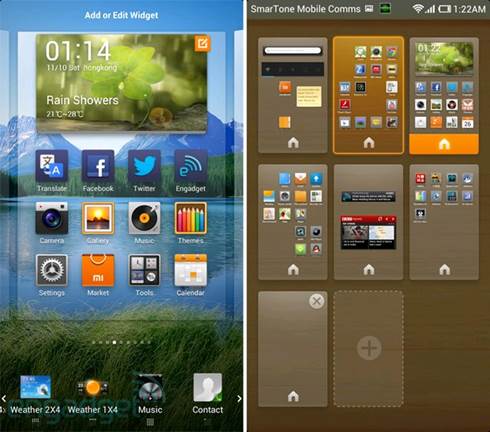One bright thing is the new voice assistant
tool package, and it is true that basically it is like Siri. Hold down the menu
at any time (unless you've set it to Google Now) and you will be greeted by the
voice which sounds familiar, along with 1 round silver button that awaits your
voice commands. This service is only available in Mandarin, but even if the language
is not a problem with you, the intelligence provided here is not with what you
have from Siri, S Voice or Google Now. Let's say a simple question about the
weather: the phone cannot assume that you are asking about the weather at your
current location, so it will always require you to specify the city.
Similarly, the assistant cannot recommend a
nearby restaurant unless you mention your location. This is one interesting
thing: we asked about the activities that we did and the answer was, "I'm
enjoying the greatness of life." Thank you very much? Despite all this,
you still may request the assistant transfer music (by Baidu Music), tell
jokes, call or send someone a text message (although it cannot recognize the
English name), require directions and set reminders. Just do not expect freedom
with your order – you have to stick with the orders. There is quite a lot of
room for improvement here, and Xiaomi can start by changing UX to avoid
angering Apple.
MIUI also has some little details, some of
which had been there for a long time. For example, if you want to move one icon
from the home screen to another home screen, you can keep your finger on it
until it is suspended, then use another finger to scroll to the desired screen.
(In fact, if you have one of the latest HTC phones, you can do the same). You
can also organize all your home screen panels by swiping with three fingers on
any panel, at this point you will see a preview of 6 to 9 panels, and you can
sort them or set the main panel to your liking.

Keep
your finger on it until it is suspended, then use another finger to scroll to
the desired screen.
An old but convenient feature that can easily
be overlooked when in lock screen is that you can hold down the home key to use
the LED as a flashlight. Last but not least, here is the new addition to our
impressive one: the "mode to prevent mistaken operation" feature refers
to the proximity sensor that detects whether the phone is in the pocket or bag,
and if that's true, it prevents any input on the touch screen if the power
button is accidentally activated. It is enabled by default, so you can leave it
there, but if it does not work for you (which we cannot imagine), it can also
be disabled (by holding the back key and volume up) or even turned off
completely.

While
there is no drawer to store all applications and utilities in MIUI, Xiaomi has
kept the same selected utilities from the Gingerbread.
While there is no drawer to store all
applications and utilities in MIUI, Xiaomi has kept the same selected utilities
from the Gingerbread – or you can swipe your home screen with two fingers or
tap the menu key and select "Edit Widgets" to enter the widget mode.
While choosing these gadgets, you'll notice there are a few spots for each utility
below it to indicate how many tiles it takes, which is quite convenient and
thoughtful. Also in this mode, you can shake the phone to arrange the icons on
the home screen. While there is no option to sort the icons in alphabetical
order, there are a few other useful settings for the launcher: you can switch
between 4x4 and 4x5 grid, change transitions (classic, crossfade, tumbling,
page, cascading, or 3D cube rotation) as well as the arrangement of the background
(which can be rolled, center, left or right).

You
can swipe your home screen with two fingers or tap the menu key and select
"Edit Widgets" to enter the widget mode.
For multi-media entertainment, the built-in
music app does quite a good job: you can sort music by artist, album, and
playlist folder; moreover, it automatically finds the lyrics synchronized for
those who want to sing. There is also the sleep timer that can be set from 1
minute to 90 minutes. The favorite part about applications is the built-in
search engine for Baidu Music, which is one incredibly big library with local
and international music (they even have the PSY Gangnam Style that comes with
lyrics in Chinese), and it works outside China mainland. By default, you can
only transfer your music over WiFi, but if there is major 3G data quota, you
can manually trigger the transmission through the mobile network in the
settings of the application. On the other hand, its own video player is not
interesting but it can process AVI, MP4 and RMVB files normally – you will have
to open it via file explorer app. If you need to see any MKV file, you will
still need to rely on third-party applications such as MX Player and PPTV
(currently very popular in China as it also provides many films and local TV
shows for streaming).
A multi-media feature which Lei Jun is very
proud of is the Dolby Mobile certificate. You can find these three settings
along the bottom of the Sound menu under system settings: off, music mode and
movie mode. They actually work quite well with the phone's external speaker on
the back, but not so well with headphones. But surely it is subjective, so new users
should notice that Dolby music mode is enabled by default.